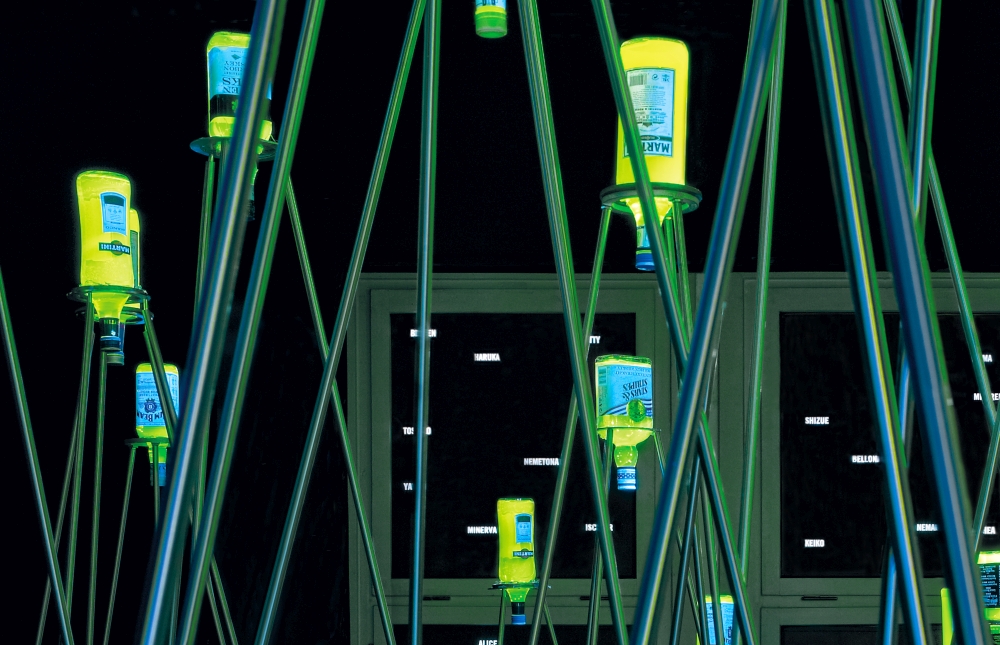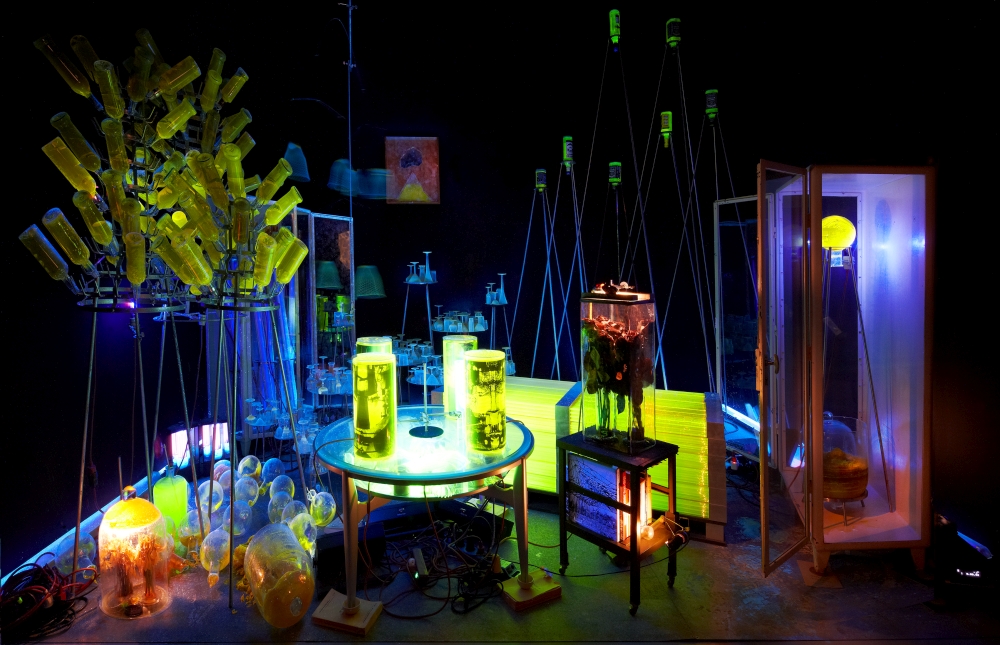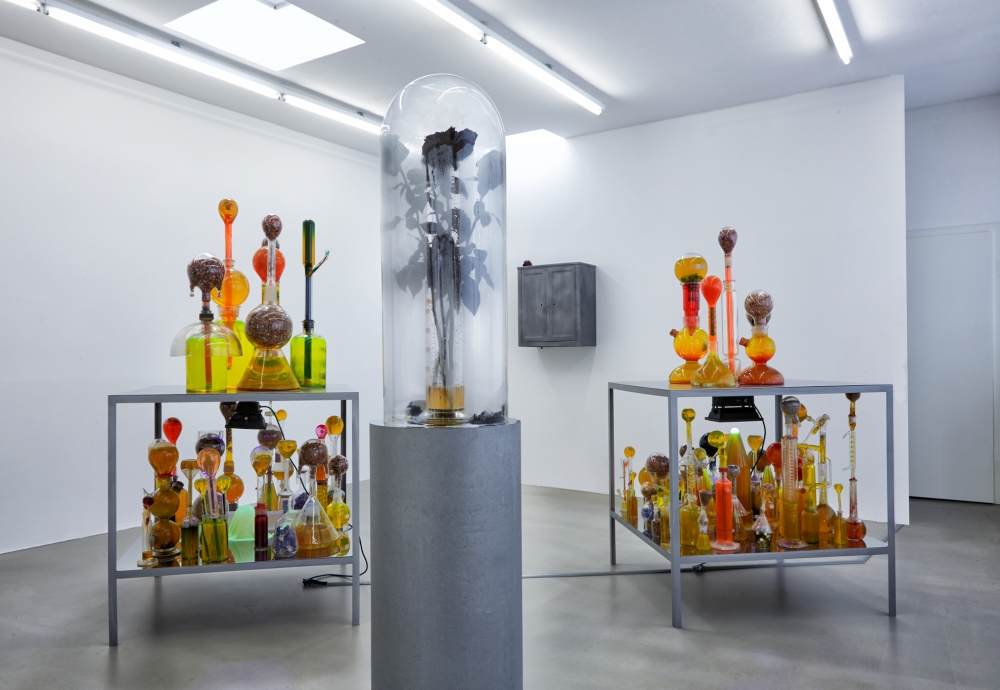Text: Stefan Oehm | Section: Articles about Artists
Summary: Sensitized at an early stage to the existential dangers and threats of modern technology, Helmut Schweizer takes the artistic and intellectual freedom in a world increasingly influenced by utilitarianism to follow a path that breathes the ancient spirit of techné, the affinity of science, technology and art. He plays with the mechanisms of science, appropriates its claim to truth with a cheeky, subversive gesture in order to point with critical awareness to the threatening dark sides of supposed blessings of progress.
1
In his truly prophetic novel The world set free, first published in 1914, the British author H.G. Wells unfurls a dystopian scenario. He describes the discovery of a source of energy of titanic dimensions: nuclear power. In the novel, not only does this herald the end of the age of coal and steel – thereby, as the causal collective result of aligned intentional actions, inadvertently unleashing economic and societal structural change on a global scale[1], thus banishing the largest part of humanity beyond the social pale – but also, quasi as a by-product and equally unintended, it begets a weapon of apocalyptic magnitude: the atomic bomb.
As history has taught us all too well, anything that is possible will one day also become probable. The weapon has entered the world. So it is only a question of time before it is put to use and disaster descends upon humanity. As the world in Wells’ dystopia is facing its own nuclear destruction this, judged in sober terms, is simply a probable though unintended result of intentional actions. After all, people ushered nuclear power into the world to make it a better place, not to destroy it.

This, however, is simply the destiny of all things of great potential. They are not controllable. At some point there’s always a glitch. Wherever and whenever. And even if it is not until the distant future: technology cannot keep running without error forever. And people have a tendency to exploit possibilities as they see fit. So it does not even require human agency, as Wells imagines, for matters to come to a head. For instance, in times of peace a profane and purely technically induced core meltdown in the decrepit Belgian nuclear power station Tihange near Aix-la-Chapelle would be quite sufficient to underscore this risk by contaminating the whole of North Rhine-Westphalia with highly radioactive fallout. Or equally, an abject fracture deformation that has been evolving over years in the salt mine in Asse in Lower Saxony, where up until the late 1970s some 126,000 barrels of nuclear waste from uranium, thorium, plutonium and arsenic production were being tipped willy-nilly into underground chambers and are now slowly rotting away. The mountain is moving, fissures opening up, ground water is seeping in and threatening to flood the entire shaft, as they say in terse mining speak, with all the radioactive waste inside it. A horror scenario, the likes of which scientists prefer not even to imagine.
2
In 1946, the year Helmut Schweizer was born, the world was in turmoil. When the first atom bomb, nicknamed Little Boy, was dropped in 1945, Wells’ anti-utopian vision had become reality. The horror of Hiroshima, followed just three days later by Nagasaki, alongside the emergence of the first images of liberated extermination camps in Germany, shook the world’s conscience. Pandora’s box had been thrown wide open, nothing would ever be the same as before.

People were unsettled, disoriented, conflicted. Old values lost all meaning, the whole world now seemed turned on its head. Old alliances fell apart, new ones were forged. Yesterday’s friends became today’s enemies and vice versa. Colonial territories began to crumble, the black continent awakened and a new communist major power emerged. With the development of Soviet nuclear weapons the Cold War was now marked by a delicate balance of terror which threatened to shatter at any moment.
Was humanity, were we ourselves as individuals, teetering over the abyss of history? How was one to deal with this confusing array of events? Ignore it, suppress it or withdraw into inner emigration? Or instead rise up in revolt and rebel? Large numbers of intellectuals in this period – artists, philosophers, psychologists, sociologists – were also agitated and swept along. With their awareness sharpened through countless debates they urged society to abandon the kind of vacuous, irresponsible and collectively determined conformism portrayed in Sloan Wilson’s The Man in the Grey Flannel Suit (1955) or Heidegger’s notion of the “Man” (the One) and to pursue self-determined individuality as described by Sarah Bakewell (2016, p. 320).

Charlie Parker’s febrile bebop improvisations smashed the stereotypes of swing. In 1949, George Orwell’s dystopian novel 1984 painted the bleak image of a totalitarian police state. From his elected French exile the Afro-American author James Baldwin wrote exasperatedly against his double stigmatisation as a black intellectual and a homosexual. In her pioneering work, The Second Sex, Simone de Beauvoir decried the degradation of women into objects under the self-appointed absolute domination of men, thereby crucially influencing feminist debate in the twentieth century. The alienated human subject became the central focus of psychotherapy which developed new analytical concepts based on existentialist ideas. In the 1955 film Rebel without a Cause, James Dean became the face of the soul-searching silent generation. And in 1963 Hannah Arendt published her book Eichmann in Jerusalem in which she powerfully labelled the bureaucrat in thrall to higher authority who sheds all individuality as the “banality of evil”.
3
In 1953, Martin Heidegger discussed The Question concerning Technology [Die Frage nach der Technik] (Heidegger, 2000)[2]. The “little magician from Messkirch”, as he was nicknamed by Karl Löwith, warned that the world was becoming increasingly utilitarian in character and guilty of the ruthless “Vernutzung” (exploitation or misuse) of its natural resources. As Heidegger saw it, modern technology considers everything in terms of function and utility. Its success together with its intrinsic hegemonial character simply perpetuates and absolutises this view, and as such ultimately reshapes all other forms of understanding the world. As a consequence, the technological view of the world predominates and, as Heidegger terms it, becomes the “Gestell”, the underlying, ordering framework.
Man ends up seeing nature as nothing more than a resource. But in so far as it is seen solely in terms of function and utility it will degenerate, as Heidegger argues, into mere “Bestand” (assets or stock) that is simply there to be tapped and processed. Man simply disregards the proper and hence true meaning of things – in other words, the meaning nature inherently has rather than that which is imputed through human agency: i.e. as is not defined by usefulness, utility and function. We thus become guilty for we are not the hub of the universe but just a guest in the terrestrial “Geviert” (the Fourfold: the entirety of earth, sky, gods and mortals), in our lived world whose care lies in our hands. Yet humanity thinks it has acquired a licence to technologically master and relentlessly avail itself of the world:
“Man has already begun to overwhelm the entire earth and its atmosphere, to arrogate to himself in forms of energy the concealed powers of nature and to submit future history to the planning and ordering of a world government.” (Heidegger, 2003, p. 372)[3].

How unfortunate then that we human beings are unable to recognise the immense danger emanating from our uncritical treatment of technology. Its sole aim is to fulfil its aimless potential. Human beings are thereby disempowered and degraded to nothing more than subservient “Besteller des Bestandes” (stock managers), reduced to small cogs in the works of a world-encompassing technological process, to nothing more than “human material”. The human being as a material resource: the ideal of autonomous thought charged with critical self-responsibility would therewith be irrevocably laid to rest.
As he revealed in a conversation with Richard Wisser on ZDF television in 1969, Heidegger was also particularly concerned “that in the foreseeable future we will be in the position to make or construct, i.e. purely in terms of organic constitution, a human being according to prevailing needs.” (Heidegger, 1988, p. 25). Faced with the destruction of our natural environment he issued an urgent warning: with the desecration of the earth by global means of technological power not only will man deteriorate into a mere resource but nature will too. It will then cease to have any other value than that as a means to an end whose loss goes hand in hand with the loss of our home (“Heimat”).
4
How can this spawn a change of thinking, a volte-face? An “essential reflection upon technology” must, says Heidegger, “happen in a realm that is, on the one hand, akin to the essence of technology and, on the other, fundamentally different from it. Such a realm is art.“[4] (Heidegger, 2000, p. 36). In such terms art proves to have originated as “techne”, but in contrast to science and technology it is not qualified by the principle of utility. A work of art, Heidegger maintains, is not created for a particular purpose. It cannot be used. Through the work of art the world is illuminated as a totality of meaning and is capable of projecting an alternative, emancipated path towards the world and towards truth, one that is not derived from the normative world view of designated purpose, benefit orientation and availability.

We have always been part of the lived world. How we think, how we act and what we are contextually defined by our “Geworfenheit” (thrown-ness) within the social, ethical, cultural or religious fabric. In addition, each lived world assumes its own distinct form in each individual. Not only that, each individual also has the capacity to a certain degree to willingly influence this distinctive form. For, as Heidegger argues, even if “Dasein” (“being-there”) has the tendency to fall beneath the dictate of the impersonal “das Man” (the One) we still have the ability and the calling to define or be ourselves. To think and act autonomously. To make decisions self-responsibly and to preserve our authenticity.

5
In Helmut Schweizer’s work the critical spirit of the time invoked by Heidegger assumes an entirely distinct and individual form of its own, sensitively interiorised in a synchronously progressing adolescence. Sensitised from very early on to the existential risks and dangers of modern technology, Helmut Schweizer embraced the artistic and intellectual liberty to pursue a path that exudes something of the old spirit Heidegger describes as “techne”. In his work he alludes to the natural affinity between art, science and technology outlined by Heidegger – in the sense that rather than working with classical artistic materials he operates within the cosmos of science and technology, deliberately not dissociating himself from them, but playing consummately with their kinship. He adapts the methodology of science and technology with the greatest possible objectivity, with rigour and precision. He contradicts prevailing hegemonic relations by giving his art the appearance of science. He experiments with its mechanisms, appropriates its claim to truth with irreverent, subversive gestures. And he founds the artistic verve of his critical intellect on a prophetic yet poetic mood that at each turn masterfully immunises his work against the danger of slipping into glib attitude.

In Schweizer’s cosmos insight presupposes thought, which for him at the same time signifies intervention in that which is alien. He breaks taboos by contravening the unwritten rules of our treatment of nature. And by so doing imposes a physical act of gaining knowledge. He provokes a new view of things, makes us more sensitive to how we treat nature so as to make us more sensitive to how we treat ourselves and each other. Akin to a scientific researcher, in his experimental habitus he probes to the very bottom of things, converts his studio into a laboratory. In his hands the scientific axiom of reiteration becomes an artistic principle, as shown in his serial works such as the photographic sequences from the 1970s, his Handlungen (1970–1977), which are arranged into tableaux. He documents, dissociates, divides, isolates, evaluates. Interferes aggressively with processes. Destroys the primordial. Forges symbols. Reveals. And through processes of decomposition makes us aware of time as a factor in all its facets as biological, calendric and biographical time.

From the mid-1970s onwards he used improvised combinations of varied stylistic elements and media such as painting, film and photography, in conjunction with less orthodox materials such as glass, plastic foil, water, chemicals and ephemeral, transient substances, to give rise to a series of complex compositions through which he repeatedly found forceful expression for his central theme of endangered nature. As can be seen in the group of works Wälder & Wasser – Bilder für C. D. Friedrich und Claude Monet (1983–1984). Or in compositions that in “vast panoramas” flow partly “into symphonies about the weeping world that feel incredibly tragic” (Schweizer) – like the groups of works created in the late 1980s, FRANZÖSISCHE LANDSCHAFTEN (1987–1988) and Deutschlandschafften (1988–1991) or the room installations that have predominated in his work since the 2000s. These include URANUS met GERMANIA (1995), Wismut. Haut & Knochen (1998–1999), MELANCHOLY & HEAVY WATER · 12/17–3/11 · TO WHOM IT MAY CONCERN dedicated to Bern Porter (1995–2014), MELANCOLIE · 12/26–3/11 · UNE SALE MARIE & LE PACIFIQUE RADIO-ACTIF · A QUI DE DROIT (2010–2014), MADHATTEN DISTRICT (1995–2010), GAS & TENDERNESS BLOWING · HARRISBURG (1:50 p.m.) (2009–2010), as well as VENEZIANISCHE ELEGIEN [Die Geburt der Tragödie · Atome der Familie · Partikelgestöber · Endlager][5] (2014–2018). All of these works convey intuitive insights that expose science’s despotically asserted notion of definitive truth to be relative and allow viewers to gain a different understanding of themselves and the world. An understanding characterised by awe and responsibility, respect and humility as opposed to shameless usurpation and exploitation.
The apocalyptic vision of civilisation’s destruction of culture that Helmut Schweizer’s art constantly parades with admirably stoic insistence clearly has no need for the elemental Promethean force of uncontrollable nuclear energy. Intervening to gain understanding – that can also be done softly.
Picture above the Text: Helmut Schweizer: VENEZIANISCHE ELEGIEN [Die Geburt der Tragödie · Atome der Familie] ( (2014–2018). Foto: Mike Christian.
This text is revised version of the German article Helmut Schweizer – Eine Annäherung [Helmut Schweizer – An Appreciation].
Translated by Matthew Partridge
[1] This idea follows the concept of the “invisible hand” advanced by the Scottish political economist Adam Smith in his work The Wealth of Nations (1776) (Smith 2007, metalibri, p. 349).]
[2] The Question concerning Technology available in English translation (1977) online: https://sites.uci.edu/art12aw18/files/2018/01/Heidegger_TheQuestionConcerningTechnology.pdf
[3] The Anaximander Fragment, available in English translation (by David Farrell Krell; Frank A. Capuzzi: in “Early Greek Thinking: The Dawn of Western Philosophy”, San Francisco: Harper & Row, 1984) online: https://dokumen.tips/documents/heidegger-anaximander-fragment.html, p. 625.
[4] The Question concerning Technology available in English translation (1977) online: https://sites.uci.edu/art12aw18/files/2018/01/Heidegger_TheQuestionConcerningTechnology.pdf, p. 19.
[5] Here Helmut Schweizer recalled a life in a period that bore great similarity to our own: Tintoretto’s Venice and the sixteenth century. Describing Tintoretto, Jean-Paul Sartre said, “His drama is our drama. That of an age in crisis. Contradictions.” (Sartre, 1991, p. 163). He was “powerless as a witness to the disintegration of the world around him” (ibid., p. 172). The idea of his group portraits was to “depict in each one of them the whole of humanity as a passive object of cataclysms, lost in a world not made for it” (loc. cit.). [Engl. transl. by Matthew Partridge]
How to cite this article
Stefan Oehm (2020): Helmut Schweizer – The Chain Reaction of Thought and Action. w/k–Between Science & Art Journal. https://doi.org/10.55597/e5537


Be First to Comment